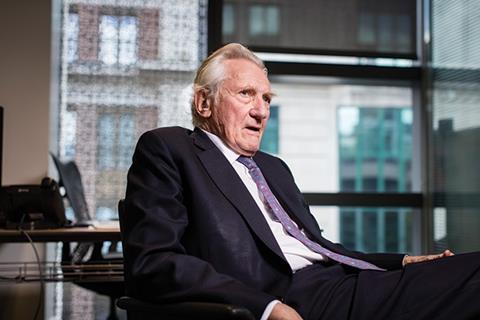While most 83-year-olds settle for a quiet life and daytime TV, Lord Heseltine’s time is taken up spearheading the government’s regeneration agenda, leading the Thames Estuary growth commission and deciding the UK’s major infrastructure priorities

Michael Heseltine is not a man with time to spare. On entering his modest office at the communities department’s headquarters in Westminster’s Marsham Street, he glances up from behind thickly black-rimmed spectacles and a mound of paperwork looking for all the world like a headmaster interrupted from his studies to scold an errant schoolboy. His expression indicates he can’t, for a second, remember which particular schoolboy and which particular transgression he is supposed to be correcting, but he quickly collects himself and apologises that he is having a particularly busy day.
∫⁄∂¥…Á«¯ has been given half an hour in his diary to quiz him on his plans ‚Äì for regeneration, the Thames Estuary and infrastructure, alongside everything else he is involved in. ‚ÄúYou couldn‚Äôt make it 10 minutes, could you?‚Äù he asks with a grin, his tone leaving open the suspicion he is not entirely joking.
Michael Heseltine, now Baron Heseltine of Thenford, can be forgiven for being brisk. A former big beast of the Thatcher and Major eras, whose Tory Party leadership challenge infamously led to Margaret Thatcher’s resignation as prime minister, he stepped down as an MP in 2001 while his party was still in the electoral wilderness. But since 2013, when he returned to the fray with a hugely influential report for chancellor George Osborne on local economic growth, he has gradually assumed a bigger and bigger influence over government thinking.
As well as being communities secretary Greg Clark’s strategic policy adviser and Osborne’s inspiration for his local devolution plans, Lord H – as he is known in Tory policy circles – is now chairing prime minister David Cameron’s drive to regenerate the 100 most deprived council estates, overseeing the government response to the closure of the SSI steel plant in Redcar, is a commissioner on the newly-formed National Infrastructure Commission, and, most recently, the chair of a commission to draw up plans to regenerate the Thames Estuary. In fact, if you work in the built environment and particularly regeneration, it’s probably quicker to list the things he’s not doing. So what does the return to the fray of the one-time deputy prime minister mean for the industry?
Political animal
Heseltine, at 83, may no longer exude the same youthful dash as he did when earning the nickname “Tarzan” as a minister in Thatcher’s first Cabinet in 1979. But there must be few octogenerians with the necessary energy for a life diarised to 15-minute intervals. Among the briefing papers a copy of his old collaborator Geoffrey Howe’s memoirs sits on his desk – the other man chiefly responsible for Thatcher’s downfall. If he is slower and more deliberate in speaking than he once was, close colleagues say he has lost none of his intellect. “There’s no flies on him,” says one. “For God’s sake don’t assume you’re talking to an old man or you’ll be in trouble. He’s sharp as a pin and misses nothing.”
Heseltine is seen by some as a kind of founding father of regeneration in the UK due to his setting up of development corporations in the Labour heartlands of Merseyside and London Docklands, to turn around urban decay through public-private partnerships. A pro-European toward the left of the party, he has evolved into a grandee with a certain cross-party appeal – lauded by former Labour deputy prime minister John Prescott for pioneering the Thames Gateway, and reportedly being lined up as a Labour adviser had Ed Miliband won the election. Though he lionises the private sector, Bob Lane, who worked with him at the Merseyside Development Corporation, and who now sits on the board of the Ebbsfleet Garden Village development, says he has a rare understanding of how targeted public investment, including through control of land, can lever in private cash to challenged areas. “He’s always been respected in Merseyside, and he always got on really well with the Labour Party there,” he says.

Thames Estuary
His most recent appointment, announced by Osborne in the Budget, is to lead a Thames Estuary 2050 Growth Commission, due to report next autumn with plans to revitalise the corridor of land leading east out of the capital north and south of the river. While the Budget reference emphasised the promotion of economic growth, the make-up of the team he has appointed indicates a clear focus on physical development. The presence of architect Lord Norman Foster and developers Tony Pidgley, Sir Stuart Lipton and George Iacobescu on the panel has already been reported, but the full 17-strong list ‚Äì revealed by ∫⁄∂¥…Á«¯ this week ‚Äì underlines this further, with the likes of Atkins CEO Uwe Krueger, Arup chairman Gregory Hodkinson, DRMM director Sadie Morgan and ICE president Sir John Armitt also involved. They sit alongside ministers, including communities secretary Greg Clark and Treasury commercial secretary Jim O‚ÄôNeill, who, Heseltine says, is there ‚Äúin order to involve the Treasury and the possibilities for private investors and institutions to play a part‚Äù.
People haven’t really perceived how powerful the devolution agenda is, How far it’s gone and how far it’s going to go. it’s unstoppable
He declines to mention Prescott’s lengthy efforts to regenerate the same area during the last decade, saying that he is going back to his original plans as environment secretary.
“Talking to Greg Clark and George Osborne … re-awakened the idea of going back to 1992 and starting again, which is what I’ve done,” he says.
“The first thing was to get a team of people. British civil engineering is building some of the most exciting projects in the world so inviting the chief executives of Arup and Atkins and Fosters was a very obvious way of bringing British expertise and overseas expertise to our deliberations.”
Heseltine’s role has already led to speculation that the setting up of further development corporations – bodies with planning powers and the ability to buy land – is on the cards in the area. This is not least because he called for exactly that in his 2013 report on local economic growth for the Treasury, No Stone Unturned. He doesn’t deny this is likely, but insists no decision has yet been taken. “This area is going to develop whatever happens. The economic forecasts are so obvious, so irresistible, that development is going to take place. The issue is to what extent government feels it appropriate to define the nature of the development and particularly the quality of the development. So the essence of the commission is to take a longer term view than market forces would inevitably do.
“Our early work will be about the ideas. And if we find the ideas that are attractive, then we can start to talk about their implementation.
In order to know where, you do need these agencies, you have to know what purpose they’re going to serve.”
Estates
While Osborne is taking an interest in the Thames Estuary, Heseltine’s £140m 100-estate regeneration programme has the backing of David Cameron, who government sources say views the policy as part of his legacy. “The prime minister’s put his name to it,” Heseltine says. “It doesn’t get more serious than that.”
I re-awakened the idea of going back to 1992 and starting again, which is what I’ve done
Whatever the patronage, many in the market have derided ¬£140m as a pitifully small sum next to the ambition, and ∫⁄∂¥…Á«¯ last month aired major concerns about whether the proposed programme can work outside of London, or secure resident support. Heseltine brushes off the fears, saying the ¬£140m of loans is merely available to help ‚Äúoil the wheels‚Äù of the process.
“Your article … misses the point. If it were accurate, it would be a substantial one – £140m is not enough to regenerate 100 estates. But it ignores the very substantial funds that this department has within its influence, and the other resources that either local government or the private sector or housing associations have.”
Will it only work where sale values are high enough to cross-subsidise new affordable homes? “No. No,” he says. “Self-evidently there’s a London dimension to this because of the high value in certain under-used sites, but that doesn’t in any way preclude the opportunities across the country. For example, you can change planning permissions which can have serious impacts on land values. You can link sites of high developable value with sites without development value in order to release the gains on one to help with the former.
“What we can do is to co-ordinate plans. We already know from the list of estates that are coming our way that there is an appetite.”
Heseltine is also keen to make clear redevelopment of estates will not happen in the face of resident opposition. “There’s nothing for anyone to be frightened of. This will only be done where the tenants want it, where the tenants feel their rights are protected and where there is a broad measure of local support.”

Infrastructure
Heseltine’s role on the National Infrastructure Commission will see him joining its other members in prioritising the major infrastructure projects the UK needs over the next 10-30 years, with the body already influential in recommending Crossrail 2 go ahead, and more investment in transport capacity in the North. Heseltine airily dismisses concerns raised already about its independence – “I listen to the dialogue, I sit on it, and I haven’t yet been told to shut up,” he jokes. He also supports the government in declining to give it responsibility for making recommendations on airport capacity: “There just has to be a point where one draws a line and says done deal, and the government can make a decision.”
Heseltine in 2013 called for the government to make an early decision on the issue, which it didn’t do, and which now looks set to be delayed until at least this autumn. However, though his position hasn’t changed, he dodges the opportunity to criticise the government for it. “I can’t make the government make the decision, they must do that. There are many complexities. Obviously you can’t have investment [without a decision]. We need a decision.”
Regeneration is back
What Heseltine’s multiple roles potentially offer is the opportunity for him to link the prioritising of infrastructure investment to questions of housing growth and local devolution, particularly in Osborne’s northern powerhouse. It is here, clearly, where he is most passionate. “I think that people haven’t really perceived how powerful the devolution agenda is, how far it’s gone and how far it’s going to go. In my view it’s unstoppable, transformational and … profound.
“No one has any doubt at all that the North is going to come together and is now enjoying a burst of potential optimism that is without precedent in my life.”
There’s nothing for anyone to be frightened of. [estate redevelopment] will only be done where there is a broad measure of local support
Regeneration, he says, is back – though he doesn’t accept it really went away. “In my experience of the present regime it’s unprecedented, the scale of commitment both in political will and in financial support.”
And is he approaching it as the same Michael Heseltine who oversaw the redevelopment in Liverpool and Docklands 35 years ago? “Yes, absolutely. All the lessons of public private partnership, of gearing public money to attract private money, of devolving power from Whitehall, to place-based economics, they were all part of the great experiment in Liverpool in 1979, or London Docklands.
“I was using existing resources to gain the maximum effect. I saw empty land, derelict. I said we’ll clean this land with public expenditure – what about we say we’ll only clean it if a private sector builder says I’ll put houses on it? So instead of a pound of pocket money, it became three.
“It’s been about drawing the public and private sectors together, working in constructive strategies on place-based economics that suited the locality, and then devolving power as that concept gathered pace and became demonstrably more successful.”
Will he continue as an adviser to see this latest set of projects through? “You should ask the good lord about that,” he jokes.
After this he only has time to fire off a last-minute warning about the dangers of Brexit to the construction industry before he moves to his next meeting. “If we vote for Brexit it will have serious damaging effects upon foreign investment in Britain and, to me, to our British influence in the world.” And with that – 35 minutes in all – he is gone.



























No comments yet